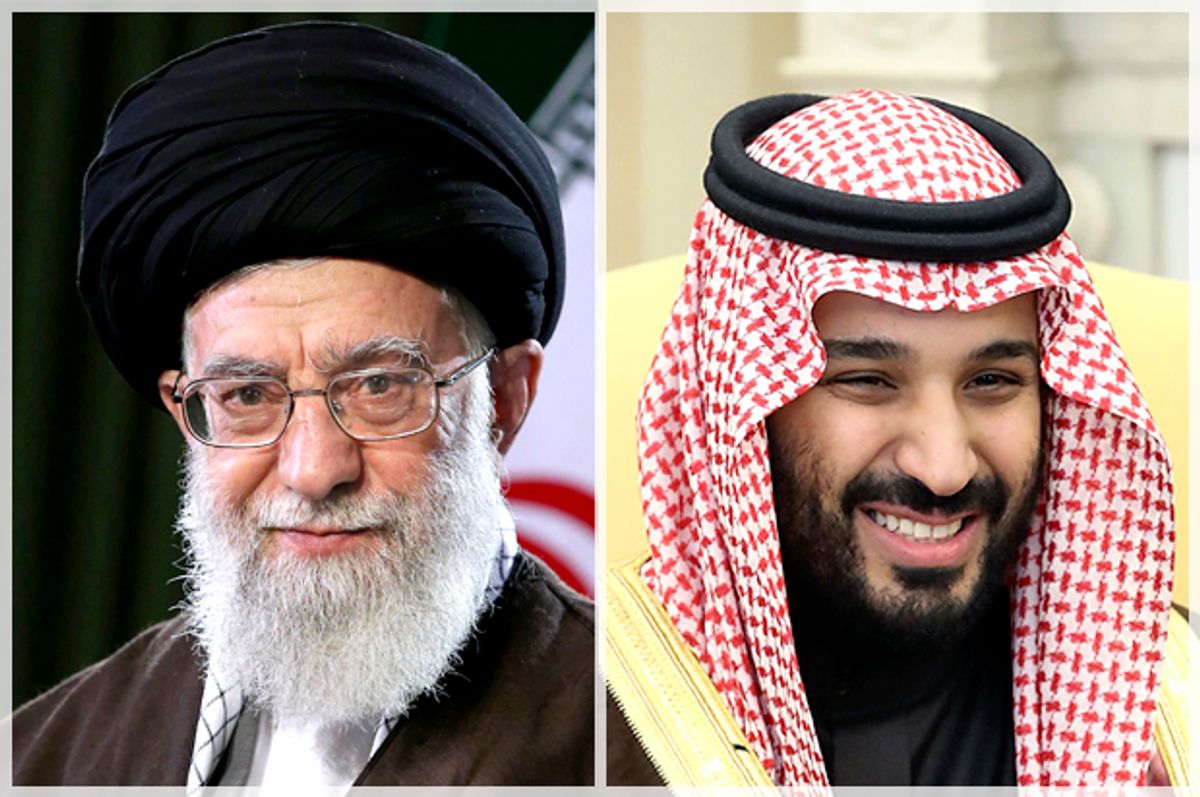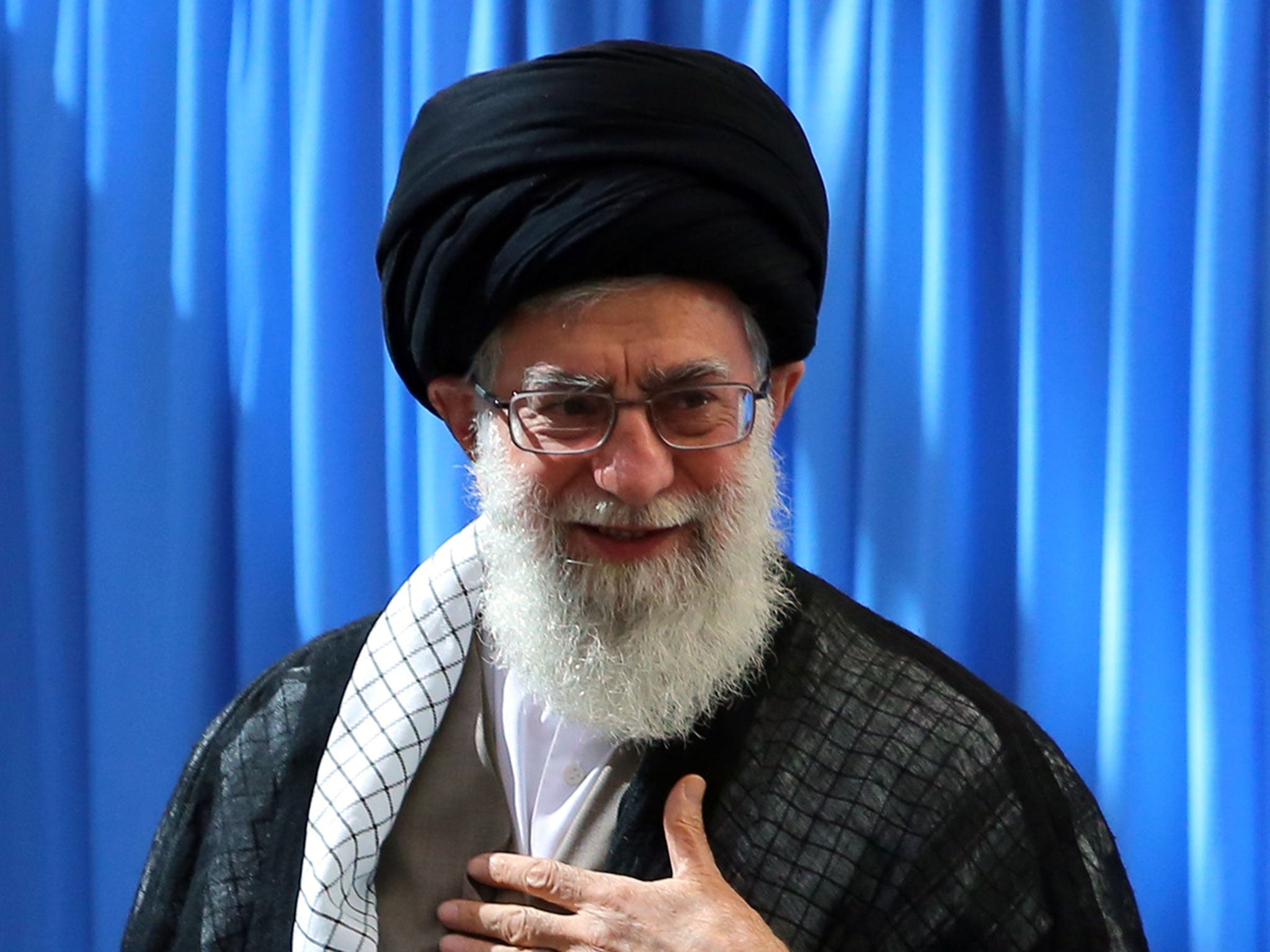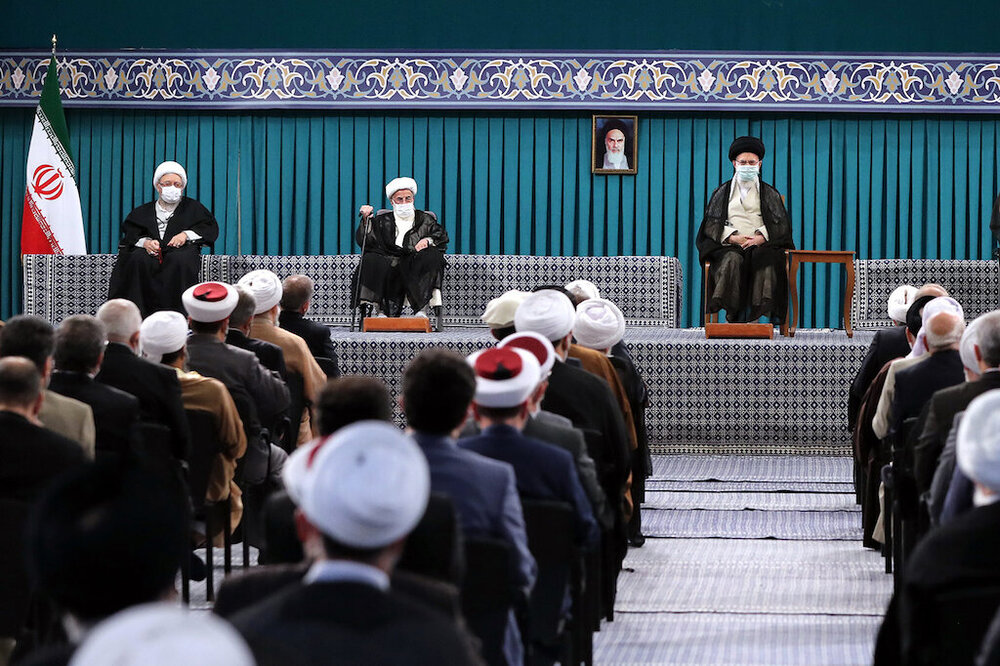Is Ali Khamenei Sunni Or Shia? Unpacking The Supreme Leader's Religious Identity
Detail Author:
- Name : Mr. Amos Stoltenberg
- Username : enos.king
- Email : darion.dare@hotmail.com
- Birthdate : 2007-07-10
- Address : 76095 Benjamin Pass Apt. 028 Hintzfort, OK 26137
- Phone : +19412771383
- Company : O'Connell and Sons
- Job : Zoologists OR Wildlife Biologist
- Bio : Qui sed est molestias nihil quidem odio. Non et sunt alias et quas voluptatem ut. Ut nihil illum voluptate enim.
Socials
facebook:
- url : https://facebook.com/ebert1973
- username : ebert1973
- bio : Omnis debitis eligendi reiciendis est aliquid tempore expedita.
- followers : 3117
- following : 1139
linkedin:
- url : https://linkedin.com/in/carter_dev
- username : carter_dev
- bio : Quam et voluptates modi illum.
- followers : 2533
- following : 1662
twitter:
- url : https://twitter.com/ebertc
- username : ebertc
- bio : Dolores qui nobis mollitia et. Eum deleniti aut iste non sunt. Magnam cum voluptatem eum molestiae rerum quia. Doloremque quas dolores doloremque.
- followers : 4842
- following : 2777
tiktok:
- url : https://tiktok.com/@carter_dev
- username : carter_dev
- bio : Laboriosam ut sed vel reprehenderit optio rerum.
- followers : 5509
- following : 652
instagram:
- url : https://instagram.com/ebert2014
- username : ebert2014
- bio : A sit cum cumque sit nostrum et. Qui at eos tenetur qui.
- followers : 3488
- following : 2459
Have you ever wondered about the religious leanings of significant global figures, especially those in positions of great influence? It's a common question, and one that, you know, really matters when we think about how countries operate and interact. When we look at Iran, the Supreme Leader, Ali Khamenei, plays a very central role, and so, his religious background is often a topic of curiosity for many people trying to get a better sense of things.
Understanding whether Ali Khamenei is Sunni or Shia isn't just about a simple label; it actually gives us a lot of insight into the very core of Iran's political system, its history, and even its place on the world stage. It's almost like trying to understand how a complex online shopping platform works without knowing its main purpose, you know? The religious identity of Iran's top leader is a key piece of the puzzle, shaping decisions and policies that, quite frankly, affect a lot of people.
This discussion helps us, in a way, explore the rich and sometimes intricate details of religious and political life in Iran. We're going to, like, unpack the question of Ali Khamenei's faith, look at the differences between Sunni and Shia Islam, and see how his religious identity fits into the bigger picture of Iran's governance. So, let's get into it and discover what lies at the heart of this important question.
Table of Contents
- Ali Khamenei's Background: A Glimpse into His Early Life and Education
- Understanding Shia Islam: A Core of Iran's Identity
- The Supreme Leader's Role in Iran: Blending Faith and Governance
- Is Ali Khamenei Sunni or Shia? The Direct Answer
- Why This Matters: The Impact of Religious Identity
- Common Questions People Ask
Ali Khamenei's Background: A Glimpse into His Early Life and Education
To truly get a sense of Ali Khamenei's religious identity, it's pretty helpful to, like, look at where he came from and how he grew up. His early life and the education he received were, very much, shaped by religious traditions and scholarly pursuits, which is something that tends to happen with leaders in such positions.
Biography: The Path to Leadership
Ali Khamenei was born on April 19, 1939, in Mashhad, Iran, a city that's, you know, quite significant for Shia Muslims. His father was a respected cleric, and this background certainly put him on a path towards religious studies from a young age. He started his religious schooling in Mashhad, learning from prominent scholars there.
Later, he moved to Qom, which is, like, a major center for Shia Islamic scholarship in Iran. There, he studied under some of the most influential figures of his time, including Ayatollah Ruhollah Khomeini, who would later become the founder of the Islamic Republic. This period was, arguably, very formative for his political and religious views.
Before becoming Supreme Leader, Ali Khamenei was, in a way, a close associate of Ayatollah Khomeini during the Iranian Revolution. He held various important roles after the revolution's success, including serving as President of Iran for two terms. This experience, you know, prepared him for the very big responsibilities he would later take on.
Personal Details: Ali Khamenei's Bio Data
Here's a quick look at some personal information about Ali Khamenei:
| Detail | Information |
|---|---|
| Full Name | Sayyid Ali Hosseini Khamenei |
| Date of Birth | April 19, 1939 |
| Place of Birth | Mashhad, Iran |
| Religious Affiliation | Shia Islam (Twelver) |
| Title | Supreme Leader of Iran |
| Predecessor | Ayatollah Ruhollah Khomeini |
| Years in Office | Since 1989 |
| Education | Qom Seminary, Mashhad Seminary |
| Father's Name | Sayyid Javad Khamenei |
Religious Education: His Journey in Islamic Scholarship
Ali Khamenei's religious education was, you know, pretty extensive and deep. He spent many years studying at the Hawza, which is a traditional Shia seminary. In Mashhad, he learned from respected teachers, getting a solid foundation in Islamic jurisprudence, philosophy, and ethics.
His time in Qom was, arguably, even more significant. There, he engaged with advanced religious texts and discussions, earning the title of Hojjat al-Islam, and later, Ayatollah. This rigorous training in Shia theology and law is, like, a fundamental aspect of his identity and authority as a religious scholar and leader. He's, you know, a very learned individual in his faith.
Understanding Shia Islam: A Core of Iran's Identity
To really grasp the answer to "Is Ali Khamenei Sunni or Shia?", it's, like, super helpful to get a basic idea of what Shia Islam is all about. This branch of Islam is, very much, central to Iran's national identity and its unique political system. It's, you know, pretty different from Sunni Islam in some key ways.
Core Beliefs: What Makes Shia Distinct
The main difference between Sunni and Shia Islam goes back to a disagreement over who should lead the Muslim community after the passing of Prophet Muhammad. Shia Muslims believe that leadership should have stayed within the Prophet's family, passing to his son-in-law and cousin, Ali ibn Abi Talib, and then to his descendants, known as Imams. This belief in the divinely appointed Imamate is, you know, a very distinguishing feature of Shia Islam.
Shia Muslims also hold certain figures, like the Imams, in very high regard, seeing them as infallible spiritual guides. They have a deep reverence for the family of the Prophet. The concept of martyrdom, especially related to Imam Hussein, is also, in a way, very significant in Shia tradition, inspiring a strong sense of justice and resistance against oppression.
There are also some differences in religious law and practices, but the core distinction, you know, pretty much revolves around the question of leadership and authority after the Prophet. It's, like, a fundamental point of divergence that has shaped centuries of Islamic history.
Historical Roots: The Great Divide
The split between Sunni and Shia Islam happened, you know, very early in Islamic history, right after Prophet Muhammad's death in 632 CE. The majority of Muslims, who later became known as Sunnis, supported the idea of choosing a leader based on consensus, and they elected Abu Bakr, a close companion of the Prophet, as the first Caliph.
A smaller group, however, believed that Ali ibn Abi Talib, the Prophet's cousin and son-in-law, was the rightful successor. This group became known as "Shiat Ali," meaning "partisans of Ali," which eventually shortened to Shia. The historical events surrounding the succession, particularly the Battle of Karbala where Imam Hussein was martyred, are, you know, very central to Shia identity and remembrance.
Over time, these initial political disagreements grew into distinct theological schools, with different interpretations of Islamic law, traditions, and leadership. This historical context is, like, pretty important for understanding the religious landscape of the Middle East today, and it, you know, directly relates to Iran's unique position.
Major Branches: Focusing on Twelver Shia
While there are several branches of Shia Islam, the largest and most prominent one is Twelver Shia Islam. This is the official state religion of Iran, and it's the branch to which Ali Khamenei belongs. Twelver Shia Muslims believe in twelve divinely appointed Imams, starting with Ali ibn Abi Talib and ending with Muhammad al-Mahdi, who they believe is currently in occultation (hidden) and will return to bring justice to the world.
The concept of the Hidden Imam is, you know, very significant in Twelver Shia thought. In the absence of the Hidden Imam, religious scholars, particularly those with the highest qualifications, are seen as having a crucial role in guiding the community. This idea, you know, pretty much forms the basis for the system of governance in Iran today.
Other Shia branches include Ismaili and Zaidi Shia, but they are, like, much smaller in number and have different beliefs about the line of Imams. For our discussion about Iran and its leader, focusing on Twelver Shia is, you know, very key.
The Supreme Leader's Role in Iran: Blending Faith and Governance
Understanding the role of the Supreme Leader in Iran is, you know, pretty essential to seeing how Ali Khamenei's religious identity fits into the country's political structure. Iran's system is, like, quite unique, combining elements of a republic with a strong religious authority. It's, in a way, a blend that's not seen very often.
Velayat-e Faqih: The Guardianship of the Jurist
The concept of "Velayat-e Faqih," or the Guardianship of the Islamic Jurist, is, arguably, the cornerstone of Iran's political system. This theory, developed by Ayatollah Ruhollah Khomeini, proposes that in the absence of the Hidden Imam, a highly qualified Islamic jurist, or Faqih, should assume leadership of the community. This Faqih has the authority to guide the state and ensure its laws align with Islamic principles.
This idea gives the Supreme Leader, who holds the position of Faqih, ultimate authority over all state matters. It means that, you know, even elected officials operate under his ultimate supervision. It's a system where religious scholarship and political leadership are, like, very much intertwined.
The Supreme Leader is, in a way, seen as the guardian of the Islamic Revolution's principles and the protector of the nation's Islamic identity. This role is, you know, pretty profound, giving him immense spiritual and temporal power.
Political and Religious Authority: How it All Works
The Supreme Leader in Iran holds, you know, both religious and political authority. As the Faqih, he is the highest religious authority in the country for Twelver Shia Muslims. This religious standing gives him immense moral authority and influence over the population.
Politically, the Supreme Leader has the final say on all major state policies, including foreign policy, defense, and key appointments. He is the commander-in-chief of the armed forces and appoints heads of the judiciary, the state radio and television, and several other powerful bodies. This means that, you know, pretty much all significant decisions ultimately pass through him.
While Iran has a president and a parliament elected by the people, their powers are, in a way, subject to the Supreme Leader's oversight. This dual structure, where popular sovereignty is balanced with religious guardianship, is, like, a very defining characteristic of the Islamic Republic of Iran. You can learn more about Iran's unique political system on our site, which, you know, explores these dynamics in more detail.
Is Ali Khamenei Sunni or Shia? The Direct Answer
So, after looking at his background and the nature of Iran's governance, the answer to the question "Is Ali Khamenei Sunni or Shia?" is, you know, very clear. Ali Khamenei is a **Shia Muslim**, specifically belonging to the **Twelver Shia** branch of Islam.
His entire religious education, his lineage, and his position as the Supreme Leader of the Islamic Republic of Iran are, like, completely rooted in Twelver Shia tradition. The very foundation of Iran's revolutionary government, established by Ayatollah Ruhollah Khomeini, is based on Twelver Shia principles, especially the concept of Velayat-e Faqih. As the successor to Khomeini, Ali Khamenei naturally upholds and embodies these principles.
This is, you know, not just a personal religious choice but a fundamental aspect of his public and political identity. It shapes his role as the spiritual and political head of a nation that is, pretty much, the world's largest Shia-majority country. His religious affiliation is, like, an undeniable fact, very much central to his being.
Why This Matters: The Impact of Religious Identity
Knowing that Ali Khamenei is Shia isn't just a piece of trivia; it, you know, pretty significantly impacts Iran's domestic policies and its relationships with other countries. This religious identity is, like, deeply woven into the fabric of the nation. It's, in a way, like understanding what kind of items are similar to what you're looking at on an online store – it helps you grasp the bigger picture.
Iran's Identity: A Shia Nation
Iran is, you know, very much a Shia-majority country, and its modern identity has been shaped by the 1979 Islamic Revolution, which was, arguably, a Shia-led movement. The principles of Twelver Shia Islam are, like, deeply embedded in the country's constitution, its legal system, and its educational institutions. This means that the government's legitimacy and its actions are often framed through a Shia religious lens.
The Supreme Leader, as the highest religious and political authority, embodies this national Shia identity. His pronouncements and directives are, in a way, seen as reflecting the will of the Islamic state. This strong religious foundation means that, you know, cultural and social norms in Iran are also very much influenced by Shia interpretations of Islam.
For example, the annual commemorations of Ashura, which mark the martyrdom of Imam Hussein, are, like, very significant national events, demonstrating the deep religious commitment of the population. This shared religious identity creates a strong sense of unity and purpose within the country, but it also, you know, sometimes creates friction with other groups.
Regional Impact: Influence Beyond Borders
Ali Khamenei's Shia identity, and by extension, Iran's Shia identity, has, you know, a very significant impact on regional politics. Iran often sees itself as a protector and supporter of Shia communities in other countries, which can, you know, pretty much lead to complex dynamics with Sunni-majority nations.
This religious dimension plays a role in Iran's foreign policy decisions, its alliances, and its rivalries in the Middle East. For instance, Iran's support for groups like Hezbollah in Lebanon or various Shia militias in Iraq is, in a way, often viewed through the lens of Shia solidarity. This can, you know, sometimes contribute to regional tensions and proxy conflicts.
Understanding this religious context is, like, pretty vital for anyone trying to make sense of the intricate web of relationships in the Middle East. It helps explain why certain alliances form and why certain conflicts persist. You can also, you know, find out more about the historical context of Iran's regional relations to understand this even better.
Common Questions People Ask
People often have a few questions when they're trying to figure out the religious aspects of Iran and its leadership. Here are some of the common ones:
What is the main difference between Sunni and Shia Islam?
The main difference between Sunni and Shia Islam, you know, pretty much comes down to who should have led the Muslim community after Prophet Muhammad's passing. Sunnis believe leadership should go to the most qualified person, chosen by consensus, while Shias believe it should stay within the Prophet's family through Ali ibn Abi Talib and his descendants, known as Imams. This difference in succession led to, like, very different interpretations of religious authority and law over time.
Is Iran a Sunni or Shia majority country?
Iran is, you know, very much a Shia-majority country. The vast majority of its population, probably around 90-95%, are Twelver Shia Muslims. This makes Iran the largest Shia-majority nation in the world, and Shia Islam is, like, the official state religion, which is, you know, pretty unique in the region.
Who was Ali Khamenei before becoming Supreme Leader?
Before becoming the Supreme Leader in 1989, Ali Khamenei was, in a way, a very prominent figure in the Iranian Revolution and its early years. He served as the President of Iran for two terms, from 1981 to 1989. He was also, you know, a close disciple of Ayatollah Ruhollah Khomeini, the founder of the Islamic Republic, and played a significant role in the revolutionary government. His background includes extensive religious studies and political activism against the Shah's regime.
Understanding these aspects, you know, really helps in seeing the full picture of Ali Khamenei's role and the context of Iran's governance. It's, like, pretty much essential for anyone looking to grasp the intricacies of the region.


